Lakota mythology is the body of sacred stories that belong to the Lakota people, also known as the Teton Sioux.

Jungle or dou shou qi is a modern Chinese board game with an obscure history. A British version known as "Jungle King" was sold in the 1960s by the John Waddington company. The game is played on a 7×9 board and is popular with children in the Far East.
Roman siege engines were, for the most part, adapted from Hellenistic siege technology. Relatively small efforts were made to develop the technology; however, the Romans brought an unrelentingly aggressive style to siege warfare that brought them repeated success. Up to the first century BC, the Romans utilized siege weapons only as required and relied for the most part on ladders, towers and rams to assault a fortified town. Ballistae were also employed, but held no permanent place within a legion's roster, until later in the republic, and were used sparingly. Julius Caesar took great interest in the integration of advanced siege engines, organizing their use for optimal battlefield efficiency.

Venture is a fantasy-themed action game released as an arcade video game in 1981 by Exidy. Each level consists of a playable, overhead map view. Upon entering one of the rooms shown on the map, the game zooms in until the room fills the screen. As a round smiley-face named Winky, the goal is to collect the treasure in each of the rooms. Winky can shoot arrows at enemies which turn into slowly disintegrating corpses when hit. Corpses are deadly to the touch. Each room has a different layout, treasure, and enemies, and some rooms have special features, such as moving walls.
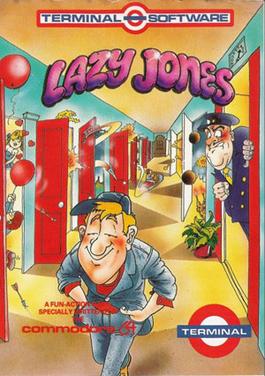
Lazy Jones is a platform game for the Commodore 64, ZX Spectrum, MSX and Tatung Einstein. It was written by David Whittaker and released by Terminal Software in 1984. The Spectrum version was ported by Simon Cobb.
The Eggerland (エッガーランド) series consists of several puzzle games developed by HAL Laboratory. Its first release was in 1985 for MSX computer systems. The gameplay is almost exactly the same across the series, with only a few changes over the years, mainly graphical.

Raven is a BBC Scotland children's adventure game show. It originally aired on CBBC in the United Kingdom from 16 December 2002 to 11 March 2010, over the course of ten series, with three spin-offs. In the original release, the show was hosted by James Mackenzie who played the title role, and conducted a group of six children, known as warriors, over five days through a series of tasks and feats. At various stages in the adventure, the group loses the least successful warrior, until two go through to the final week to compete for the title of Ultimate Warrior.

Egypt is a puzzle video game released for the Family Computer in 1991 by Human. It was released only in Japan. It is an object elimination type puzzle game. A player controls a spherical jewel and jumps from tile to tile. Stepping on an arrow shifts a row or column in the direction of the arrow. Placing two or more of the same object next to each other will erase them from the board, and this must be repeated until all the objects have been eliminated from the board.

God of Thunder is a puzzle game for MS-DOS created by Ron Davis and published by Software Creations in 1993. It was released as shareware, then became freeware circa-2002. The plot and characters are based on Norse mythology with tongue-in-cheek humor.
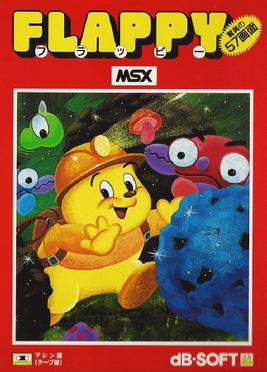
Flappy is a puzzle game by dB-Soft in the same vein as the Eggerland series and Sokoban that is obscure outside Japan. It features Flappy, a somewhat mole-like character who must complete each level by pushing a blue stone from its starting place to the blue tile destination.

Nail 'n' Scale, known as Dragon Tail (ドラゴンテール) in Japan, is a puzzle video game developed by Data East for the Game Boy. A combination of the video game Jump'n Run and various puzzle games, it has a fast-paced side-scrolling gameplay.
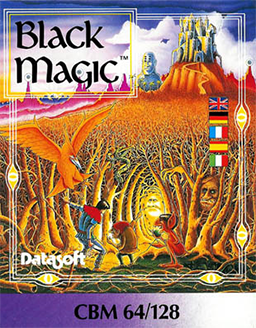
Black Magic is a multidirectional scrolling action-adventure game written for the Apple II by Peter Ward of Action Software and published by Datasoft in 1987. Commodore 64, ZX Spectrum, and Amstrad CPC versions were also released.
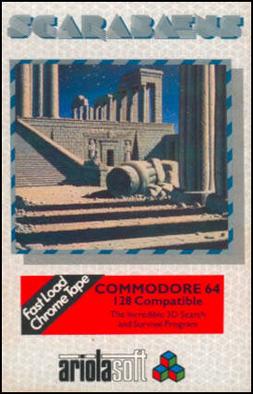
Scarabaeus, known in America as Invaders of the Lost Tomb, is a computer game released for the Commodore 64 in 1985. It was written in Hungary by Andromeda Software and distributed in the UK by Ariolasoft. The storyline features an astronaut and his dog who explore an Egyptian tomb and need to find the Pharaoh's Jewel by solving puzzles spread over three levels. The game is played in 1st person view. A sequel was said to be in development in 1986 but was never released.

Raven: The Secret Temple is a BBC Scotland children's adventure game show, and the second spin-off to the main series, Raven. It comprises one series, which aired first on the CBBC Channel, and then during CBBC on BBC One in the United Kingdom, in 2007. In this series, warriors compete as teams and attempt to collect as many jewels as possible by completing fourteen tasks, so that they may find and enter the Secret Temple.
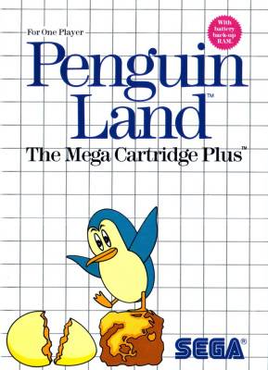
Penguin Land, known as Doki Doki Penguin Land Uchū Daibōken in Japan, is a 1987 puzzle-platform game published and developed by Sega for the Master System. It is the second game in the Doki Doki Penguin Land series. The player controls a penguin to guide an egg around polar bears, rocks and other hazards. There are 50 stages and a level editor which can save up to 15 additional levels. The level editor data is stored on the game's battery back-up RAM. Penguin Land was the first home console video game to include a battery backup save feature being released four days prior to The Legend of Zelda in the US.
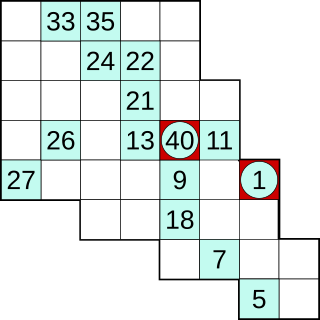
Hidato, also known as "Hidoku", is a logic puzzle game invented by Dr. Gyora M. Benedek, an Israeli mathematician. The goal of Hidato is to fill the grid with consecutive numbers that connect horizontally, vertically, or diagonally. The name Hidato is a registered trademark. Some publishers use different names for this puzzle such as Number Snake, Snakepit, Jadium or Numbrix.
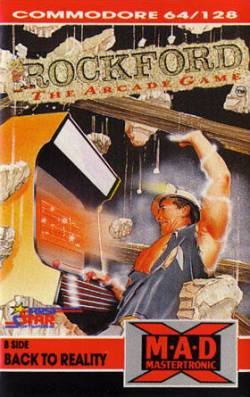
Rockford is a 1988 arcade game developed by Mastertronic's Arcadia Systems as an arcade spin-off of the home computer series Boulder Dash. The original arcade version of Rockford ran on the "Arcadia Multi Select system", an Amiga 500-based system that supported multiple games.
Since its debut in 1981, the Indiana Jones franchise has become part of American popular culture. References have been made in television series, movies, music and other material since the original film was released.

The trim of a diver is the orientation of the body in the water, determined by posture and the distribution of weight and volume along the body and equipment, as well as by any other forces acting on the diver. Both static trim and its stability affect the convenience and safety of the diver while under water and at the surface. Midwater trim is usually considered at approximately neutral buoyancy for a swimming scuba diver, and neutral buoyancy is necessary for efficient maneuvering at constant depth, but surface trim may be at significant positive buoyancy to keep the head above water.

Lara Croft Go is a turn-based puzzle video game in the Tomb Raider series. The player moves Lara Croft as a puzzle piece through a board game while avoiding obstacles and manipulating the environment. The developers distilled major series motifs, such as boulder-chases and reaction-based gameplay, to suit Lara Croft Go's time-independent gameplay. Square Enix Montréal developed the game as a spiritual successor to its 2014 Hitman Go, based on another Square Enix Europe franchise. It was released in August 2015 for Android, iOS, Windows, and Windows Phone devices. Versions for PlayStation 4, PlayStation Vita and Steam were released in December 2016.

















